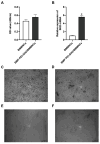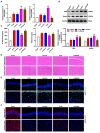Magnetic nanomagnetic nanoparticles combining with Slit2 gene and bone marrow mononuclear cells to improve cognitive dysfunction in rats with chronic cerebral ischemia
- PMID: 39239546
- PMCID: PMC11373550
- DOI: 10.7150/ijms.97051
Magnetic nanomagnetic nanoparticles combining with Slit2 gene and bone marrow mononuclear cells to improve cognitive dysfunction in rats with chronic cerebral ischemia
Abstract
Purpose: Cognitive dysfunction caused by chronic cerebral hypoperfusion (CCH) is the leading cause of vascular dementia. Therefore, it is necessary to explore the mechanism that causes cerebral injury and find an effective therapy. Methods: Bone marrow mononuclear cells (BMMNCs) were extracted to detect the activity by CCK-8 kit and verify the transfection efficiency using reverse transcription-quantitative real-time polymerase chain reaction (RT-qPCR). A CCH rat model was established. Superparamagnetic iron oxide nanoparticles (BMPs)-PEI-Slit2/BMMNCs were injected into the tail vein and intervened with an external magnetic field. Hematoxylin and eosin staining was used to observe the pathological changes in brain tissue. The Slit/Robo pathway-related proteins Slit2 and Robo4 were detected by RT-qPCR and Western blotting. Results: The neurological score of the CCH group significantly increased compared with that of the sham group (P<0.05). The levels of brain injury markers S-100β and NSE were significantly higher in the CCH group than in the sham group (P<0.05). Neuronal apoptosis in the frontal cortex and hippocampus of CCH rats significantly increased compared with that of the sham group (P<0.05). The expression levels of Slit2 and Robo4 mRNAs and proteins in brain tissue of CCH rats significantly increased (P<0.05). The neurological function scores of CCH rats treated with BMP-PEI-Slit2/BMMNC significantly increased after Robo4 siRNA administration (P<0.05). Conclusion: BMP combination with the CCH-related gene Slit2 can effectively improve the efficiency of BMMNC transplantation in treatment.
Keywords: bone marrow mononuclear cells; chronic cerebral hypoperfusion; rat; superparamagnetic iron oxide nanoparticles.
© The author(s).
Conflict of interest statement
Competing Interests: The authors have declared that no competing interest exists.
Figures






Similar articles
-
Recombinant Slit2 attenuates neuroinflammation after surgical brain injury by inhibiting peripheral immune cell infiltration via Robo1-srGAP1 pathway in a rat model.Neurobiol Dis. 2016 Jan;85:164-173. doi: 10.1016/j.nbd.2015.11.003. Epub 2015 Nov 10. Neurobiol Dis. 2016. PMID: 26550694 Free PMC article.
-
Novel regulated expression of the SLIT/ROBO pathway in the ovary: possible role during luteolysis in women.Endocrinology. 2008 Oct;149(10):5024-34. doi: 10.1210/en.2008-0204. Epub 2008 Jun 19. Endocrinology. 2008. PMID: 18566128
-
Increased Expression of Slit2 and its Robo Receptors During Astroglial Scar Formation After Transient Focal Cerebral Ischemia in Rats.Neurochem Res. 2016 Dec;41(12):3373-3385. doi: 10.1007/s11064-016-2072-0. Epub 2016 Sep 29. Neurochem Res. 2016. PMID: 27686659
-
Increased expression of Slit2 and its receptors Robo1 and Robo4 in reactive astrocytes of the rat hippocampus after transient forebrain ischemia.Brain Res. 2016 Mar 1;1634:45-56. doi: 10.1016/j.brainres.2015.12.056. Epub 2016 Jan 4. Brain Res. 2016. PMID: 26764532
-
Bone Marrow-Derived Mononuclear Cells in the Treatment of Neurological Diseases: Knowns and Unknowns.Cell Mol Neurobiol. 2023 Oct;43(7):3211-3250. doi: 10.1007/s10571-023-01377-x. Epub 2023 Jun 25. Cell Mol Neurobiol. 2023. PMID: 37356043 Free PMC article. Review.
References
-
- Kalaria RN. The pathology and pathophysiology of vascular dementia. Neuropharmacol. 2018;134(Pt B):226–39. - PubMed
-
- Wang XX, Zhang B, Xia R, Jia QY. Inflammation, apoptosis and autophagy as critical players in vascular dementia. Eur Rev Med Pharmacol Sci. 2020;24(18):9601–14. - PubMed
-
- Wolters FJ, Ikram MA. Epidemiology of Vascular Dementia. Arterioscler Thromb Vasc Biol. 2019;39(8):1542–9. - PubMed
MeSH terms
Substances
LinkOut - more resources
Full Text Sources

